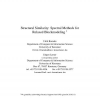Free Online Productivity Tools
i2Speak
i2Symbol
i2OCR
iTex2Img
iWeb2Print
iWeb2Shot
i2Type
iPdf2Split
iPdf2Merge
i2Bopomofo
i2Arabic
i2Style
i2Image
i2PDF
iLatex2Rtf
Sci2ools
CLASSIFICATION
2010
2010
Structural Similarity: Spectral Methods for Relaxed Blockmodeling
| Added | 01 Mar 2011 |
| Updated | 01 Mar 2011 |
| Type | Journal |
| Year | 2010 |
| Where | CLASSIFICATION |
| Authors | Ulrik Brandes, Jürgen Lerner |
Comments (0)

